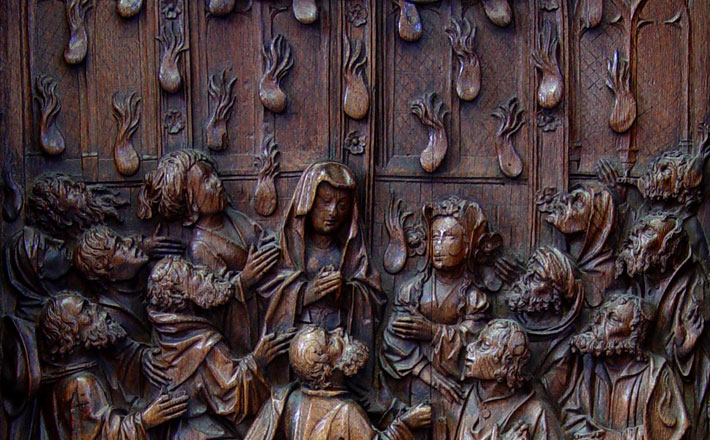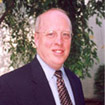Commentary on Acts 2:1-21
One challenge of preaching on major festival days such as Christmas, Easter, or Pentecost lies in their familiarity.
If familiarity does not exactly breed contempt, it does tend toward the domestication of scripture’s most unruly, norm-busting stories. Incarnation, resurrection, and the outpouring of God’s Holy Spirit upon all flesh find themselves toned down into quiet images of a baby in a manger, a bunny with a basket, and a burning breeze that swept through some distant place in a distant age, leaving perhaps only a trace of its passage among our own people in our own time.
Another part of the challenge lies in how the story has been told. The post-resurrection band of believers has regrouped after the violent crucifixion of their leader and a devastating betrayal by one of their inner circle (Acts 1:15-26). Through the quiet intercession of the Spirit, a replacement for Judas has been selected, and — with decency and order restored among their ranks — they stand ready to bear witness to the gospel and the resurrection. And, ready or not, the Spirit of God visits them and says, “You think resurrection was something? Wait until you see what’s next.”
The history of art and imagination has left us a paltry legacy of depicting the narrative tumult of this story. (Do a Google Image search for “Pentecost” and you’ll see.) Art history mainly leaves us with small, polite tongues of fire dancing through a room or resting as unobtrusively as possible (for fire) upon the heads of people calmly sitting in their places. There seems to be little that would draw a crowd of onlookers or invoke much more of a summation than a simple, “That was weird” before observers turn to what’s next. It’s like a Facebook post or viral video that is quickly forgotten rather than a story whose impact and possibilities endure after 2,000 years.
English translations also underplay the fear-inducing, adrenalin-pumping, wind-tossed, fire-singed, smoke-filled turmoil of that experience. Those who observed this Pentecost visitation from outside the room are described in the NRSV as “bewildered” (v. 6), “amazed and astonished” (v. 7), and “amazed and perplexed” (v. 12). The Greek terms describing their reactions could be appropriately rendered (following the lead of various lexicons) as confused, in an uproar, beside themselves, undone, blown away, thoroughly disoriented, completely uncomprehending. It’s important to release this story from its 2,000 year long domestication. Its connections to some of scripture’s most primal, disorderly, prophetic roots open doors into a liberating, open-ended array of possibilities made possible by the unconstrained Spirit of God.
- Pentecost as a major festival day did not originate with the Christian church. It was a Jewish festival commemorating the giving of the Law, its occurrence fifty days after Passover corresponding with tradition that Moses received the Ten Commandments fifty days after the Exodus. Acts takes a core story of liberation from slavery and the continuing presence of the God and adds a new dimension of liberation from death (the resurrection) and its continuing impact on individuals and communities of believers who are open to God’s Spirit.
- Surprisingly, the essential voice for Pentecost in Acts is neither Moses, the lawgiver, nor Jesus, the risen one, but the Spirit. Jesus first appears nine verses into Peter’s sermon interpreting the experience (v. 22), after the end of this pericope. Peter begins with the prophet Joel (v. 16), through whom God spoke — true to the prophetic tradition — in ways that brush aside our human categories, distinctions, and societally-established roles.
If we are used to thinking of any group as a better or more divinely-ordained voice for conveying the plans and purposes of God, God’s Spirit tells us otherwise. All flesh — boys and girls, young and old, free and slaves — whether they be women or men — are graced with the Spirit’s direct connection to the prophecies, visions, and dreams of God (vv. 16-21). This was institutionally unsettling back then and is institutionally resisted today. In this story, God shows no regard for our structures, hierarchies, or status quo. Even the basic, predictable structures of the cosmos are not exempt from whatever God has in store for creation (vv. 19-21). God’s unstoppable drive toward new creation is made visible in the disorienting experience that God’s revelation reaches even deeper than the isolations brought about by human cultures, nationalities, and languages (vv. 5-16). God speaks through our words and actions and does not pause in the face of what we see as insurmountable barriers that actually exist only by our own creation.
- The wind of Pentecost connects to the accounts of the wind (spirit) of God moving over the abyss before creation (Genesis 1:1-2), driving back the flood in the time of Noah (Genesis 8:1), separating the waters of the sea to let Israel pass through from slavery to freedom (Exodus 14:21-22), and signaling to Elijah that God’s fearsome power is, sometimes, best heard through a still, small voice (1 Kings 19:11-18). The fire of Pentecost connects to the smoking fire pot and flaming torch that sealed the covenant with Abram (Genesis 15:1-17), the burning bush at the call of Moses (Exodus 3:2), the pillar of fire that guided the Israelites through the wilderness (Exodus 13:21), the cleansing fires of Psalms (46:9, 50:6, etc.), and the judging, consuming fires of Elijah and the prophets (1 Kings 18; Isaiah 5:24, 9:2b-7, 29:6; Jeremiah 4:4, 21:12-3; Hosea 8:14; Amos 7:4-5; Micah 3:1-5, etc.).
Taken alone, these images of wind and fire as agents of God’s power, judgment, and purification present a one-dimensional portrait of the divine relationship with creation. Joel’s image cited by Peter includes these elements, which, as noted, have their own unsettling, destabilizing implications that cannot be ignored. At the same time, as Joel and Peter proclaim the unconstrained work of the Spirit within and among all of humanity, they proclaim it with a redemptive purpose that also cannot be ignored: Though “the sun shall be turned to darkness and the moon to blood, before the coming of the Lord’s great and glorious day” (v. 21), it stands as a great and glorious day because it heralds the time when “everyone who calls on the name of the Lord shall be saved” (v. 21). That day is now. Among all the primal, unconstrained purposes of God, God’s desire for redemption, new creation, and salvation reigns supreme, regardless of any barriers we create that stand in its way.


May 24, 2015